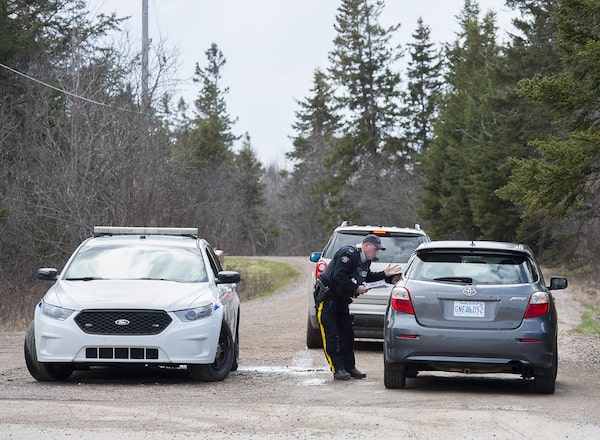
An RCMP officer talks with a local resident before escorting them home at a roadblock in Portapique, N.S. on April 22, 2021.Andrew Vaughan/The Canadian Press
The head of Nova Scotia’s Emergency Management Office sayshe found it surprisingthe RCMP waited so long to issue a provincewide alert about a gunman who killed 22 people during a 13-hour rampage in April 2020.
The inquiry investigating the tragedy released documents Tuesday that include a recent interview with the EMO’s executive director, Paul Mason, who confirmed for the first time that the Mounties hadn’t considered using the Alert Ready system until his organization suggested it.
“At the end of the day, it didn’t cross their minds,” Mason told inquiry investigators on Feb. 15.
“I find it surprising you could have an event go on from like 10:30 on Saturday night till 11:30 on Sunday and nobody thought about an alert until we called them.”
The RCMP have confirmed the text for an alert, which would have been transmitted to most radios, TVs and cellphones once approved by EMO, was being drafted when the shooter was killed by police at a gas station north of Halifax at 11:26 a.m. on April 19, 2020.
The police force has faced intense scrutiny for its decision not to use the system until long after the killer’s rampage started.
The inquiry has heard the RCMP largely relied on Twitter to issue public warnings about what was happening. But some of the victims’ relatives have complained the warnings on social media were of little use to people in rural settings, where Twitter isn’t that popular.
As well, previously released evidence has confirmed senior RCMP officers were worried that a broader public alert could have put officers in danger by causing a “frantic panic.” The Mounties have also suggested that 911 operators could have been overwhelmed by callers seeking information.
Mason said his organization did not become aware of the severity of the situation until April 19, 2020, at 10:17 a.m., when the RCMP posted a tweet showing a photo of the killer’s vehicle – a 2017 Ford Taurus Interceptor that was modified to look exactly like a marked RCMP cruiser.
“When I saw the police cruiser, it was the first indication we had that this person was moving around … (in a) fake RCMP car,” Mason told the inquiry Tuesday.
The tweet about the vehicle was the first time the Mounties confirmed for the public what they had been told by several witnesses the night before when the gunman, disguised as a Mountie, killed 13 people in Portapique, N.S., before escaping in his replica cruiser at around 10:45 p.m.
Mason said staff at EMO tried calling the RCMP on the morning of April 19, at around 10:30 a.m., but they couldn’t get through. “Basically, we couldn’t get hold of anyone,” he told inquiry investigators in February, adding he was surprised the Mounties had not reached out to EMO.
“We wouldn’t have needed all the information. All we would have needed to know is (they) were considering issuing an alert. Would this qualify? And in light of what was going on and the fact that this was not confined to a local area … we would have said yes.”
The EMO office was already open that Sunday because staff were preparing a report on the worsening COVID-19 pandemic. The office had used the Alert Ready system earlier in the month to issue warnings about the spread of the virus.
The RCMP called back at 11:20 a.m. to confirm they wanted to use the alert system, Mason said. But the Mounties had yet to submit the text they wanted distributed, he said.
“I was on the phone with my deputy minister telling her that we were going to issue an alert as soon as we had the authorization (and) the message from RCMP,” he said in February. “That was around 11:25 or so. And then we got the notification shortly thereafter that (the killer) was in custody.”
EMO never received an alert from the RCMP.
Mason said the Mounties were well aware of the system’s capabilities.
Three years earlier, the RCMP rejected an EMO offer to assume responsibility for issuing alerts on their own.
The offer was made because police services have round-the-clock staffing and are “better positioned to respond quickly to unfolding events,” according to a summary of evidence released Tuesday.
The document, known as a foundational document, refers to a meeting in June 2016 that included EMO, the RCMP, Halifax Regional Police and Cape Breton Regional Police.
On June 27, 2016, Mason sent an email to the RCMP and Halifax police, suggesting that some alerts “could be handled more expeditiously via law enforcement directly,” and police could benefit from “control of the message content (and) timelines.” But the proposal went nowhere.
“The offer was not accepted by any of these police services,” the document says. There is no explanation from the RCMP in the document.
“I think (our) interest with the RCMP is as the largest … police force, covering the largest geography in the province, and with a 24/7 communications centre,” Mason said in his interview with the inquiry. “But they were not interested.”
That position changed after the worst mass shooting in modern Canadian history.
On April 30, 2021, the RCMP’s Nova Scotia commander, assistant commissioner Lee Bergman, signed an agreement authorizing the Mounties to issue their own alerts through the Alert Ready system.
“That’s something we had advocated for, for quite a while,” Mason said Tuesday.
Our Morning Update and Evening Update newsletters are written by Globe editors, giving you a concise summary of the day’s most important headlines. Sign up today.